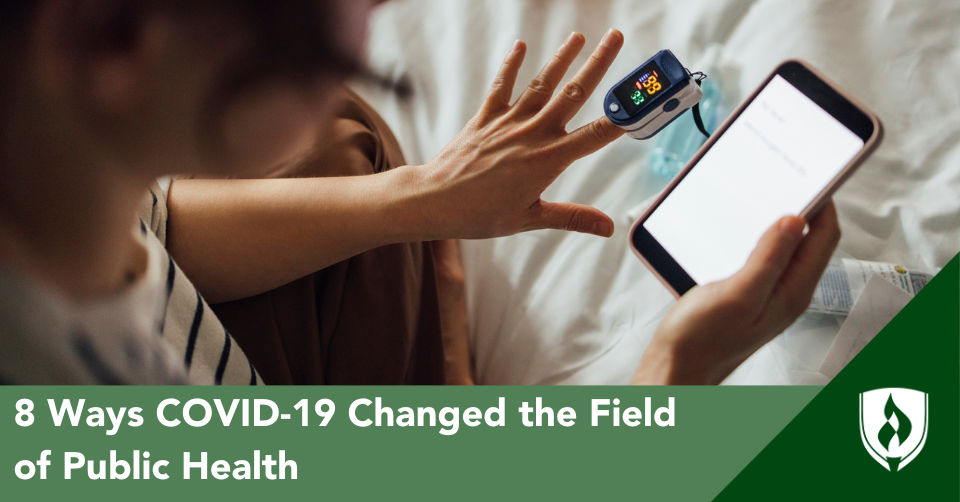8 Ways COVID Changed the Field of Public Health: Pandemic Healthcare Innovation
By Robbie Gould on 08/08/2023

In the aftermath of the Covid-19 pandemic, the public health field underwent a significant shift, reevaluating its understanding and approach to promoting, protecting and facilitating the well-being of individuals and communities.
As the world grappled with the crisis, a stark realization emerged. Our health system’s vulnerabilities, exacerbated by catastrophic illness and fatalities, became clearer to the general public.
At the same time, the heroism and mind-boggling determination of healthcare workers across the country also shone clear. In a way, the pandemic illustrated our desperate need for solutions in healthcare while also showcasing that people in this field are a force to be reckoned with.
It probably won’t surprise you to learn that COVID-19 has changed things in healthcare for good. And none of those changes are more obvious than in the field of public health.
8 Ways COVID-19 Has Changed Public Health
Big change in any industry is hard to make—but some of these pandemic changes are happening with surprising alacrity. Read on to get a picture of the healthcare innovations underway.
1. Healthcare is increasing focus on infectious disease management
One of the biggest changes the Covid-19 pandemic influenced was the replacement of traditional health concerns, says Dr. Shara Cohen, the founder of Cancer Care Parcel. While there had been significant emphasis on issues like cancer, obesity or heart disease, increased focus went to concerns of "infectious disease control, contact tracing and vaccination". Less urgent health services were canceled or postponed, leaving a large wake of disruption for many people.1
The pandemic also brought about significant changes in the way infectious diseases are managed. How could we forget: prevention strategies such as mask-wearing, stay-at-home orders and social distancing became common. Testing and contact tracing played a crucial role in early detection and containment, and quarantine and isolation protocols became a normal thing to break the chain of transmission.
2. Vaccine development and distribution hurdled some huge learning curves
The pandemic definitely shook things up in the world of vaccine development and distribution. People all around the globe joined forces and poured in lots of money, speeding up the development of vaccines.2 We also streamlined the process of getting approval for vaccine candidates with emergency use authorizations. In the same period, manufacturing got a major boost, and distribution plans across the country went into action.
The successes or failures of public health plans when it came to vaccine distribution also gave us plenty of data to analyze. This information is so useful to shape distribution plans in the future.
3. Health agencies got faster at utilizing health surveillance and monitoring
Health agencies have bolstered surveillance systems to track and monitor disease outbreaks, implement effective contact tracing and identify potential hotspots.3
This type of system is nothing like CCTV. Healthcare surveillance is more about creating information pathways between insurance companies and medical claims as well as electronic health records where possible to detect rises in viral cases.
Other detection efforts like wastewater surveillance systems, passive reporting from individuals or local organization and more can all contribute to a wider network of awareness.
One of the key areas where surveillance was enhanced was in data collection and analysis. Robust systems were put in place to gather comprehensive data on Covid-19 cases, testing rates, hospitalizations and mortality. This real-time data played a crucial role in understanding population health, disease patterns, hotspots and health care interventions.
The pandemic also accelerated the adoption of innovative technologies and digital tools, including contact tracing apps and online reporting systems, to facilitate the collection and analysis of data and data sources
4. Many sectors strengthened their health infrastructure
The Covid-19 pandemic also had a profound impact on strengthening health infrastructure, including health services utilization.4 Here are some of the key improvements:
- Expanded patient care facilities, including temporary hospitals.
- Better stockpiling of medical equipment and protective gear.
- Wider adaptation of telehealth options
- Increased efforts to recruit healthcare workers
- Intensified efforts in public preparedness research
5. Professionals inside and outside healthcare worked harder at collaboration
"Another significant change is the increased cross-sector collaboration," says Dr. James Walker, a clinical doctor with over 10 years of experience managing patients. "Public health professionals, healthcare providers, scientists, government agencies and even the tech industry are working together to develop solutions."
The Covid-19 pandemic brought people and organizations together like never before in a grand effort to tackle the pandemic collectively. Countries, researchers and companies collaborated to share information and develop vaccines, treatments and tests, and public and private sectors worked together to speed up vaccine production and distribution.
Within health systems, partnerships improved patient care and resource allocation. Communities and local organizations joined forces to spread awareness and support vulnerable groups, and philanthropic collaboration increased funding and resources for various initiatives.
The pandemic showed us the power of working together to overcome global health challenges.
6. Digital health and telemedicine got a massive boost
"The most noticeable change has been the digitalization and decentralization of healthcare services," Dr. Walker says. "The reliance on data-driven decision-making has never been greater, and the push toward digital health can increase access to health care and other services."
The Covid-19 pandemic led to a rapid increase in telemedicine adoption, allowing people to receive medical care remotely.5 Healthcare providers invested in telehealth infrastructure, enabling secure virtual consultations.
Regulatory changes facilitated the use of telemedicine by relaxing restrictions and expanding reimbursement. This change was huge in terms of making telemedicine a permanent healthcare option.
Remote patient monitoring gained importance as well with capacity issues and the increased need to track cases of COVID-19.
Telemedicine improved access to healthcare, especially for remote areas and vulnerable populations. These changes will continue to drive innovation and transform the delivery of health services in the future.
7. Health equity problems and social determinants of health became glaring
The Covid-19 pandemic significantly impacted health equity and our understanding of social determinants of health, placing a large responsibility on public health professionals to address many inequities.6
Existing disparities were exposed and worsened, affecting marginalized communities the most. Access to care became a crucial issue, with barriers like insurance, limited facilities and transportation challenges hindering vulnerable populations. Economic consequences (like lost employment) widened inequities, while mental health disparities were exacerbated.
The pandemic also spurred policy and system changes to promote equitable care. With more public attention on these issues, both organizations and individuals are looking to create change.
8. Mental health wove deeper into the healthcare industry
Traditionally, mental health has been treated as an outlier of healthcare. The pandemic sparked an increase in mental health education and reduced the stigma around mental health care.7
As not only patients, but healthcare workers around the country experienced detrimental impacts to their mental health, the need for more connectivity between psychological and medical care became clearer. Health organizations are working toward increased insurance coverage for mental health treatment, better incentives and recruitment for mental health professionals, and wider, more affordable access to treatment options.
The future of public health continues with you
The Covid-19 pandemic has left an indelible mark on the field of public health, reshaping it in so many ways. One of the most important impacts, however, is very possibly the increased awareness the general public has of essential roles.
Before the pandemic, the field of public health was likely only something you considered if you stumbled onto it during your education. But now, with so many years of paying attention to the country’s healthcare crisis response, there’s more awareness about this incredible field.
And maybe, more people will consider pursuing these careers to help make the impacts our society needs.
Does the idea of a career in public health sound appealing to you? A Health and Wellness Bachelor’s degree can help prepare you to lead community health education programs.
At the graduate degree level, the Rasmussen University Master of Public Health degree program can equip you with the skills needed to conduct research and craft public health policy from a variety of leadership roles.
The Master of Public Health program at Rasmussen University is not designed to prepare graduates for any state-issued professional license or certification and has not been approved by any state professional licensing agency. For further information on licensing requirements, please contact the appropriate board or agency in your state of residence.
1Geddes L. VaccinesWork. How the COVID-19 pandemic has affected healthcare around the world. Date accessed 6/27/23. https://www.gavi.org/vaccineswork/how-covid-19-pandemic-has-affected-healthcare-around-world
2U.S. Department of Health and Human Services. From the Factory to the Frontlines The Operation Warp Speed Strategy for Distributing a COVID-19 Vaccine. Date accessed 6/27/23. https://www.hhs.gov/sites/default/files/strategy-for-distributing-covid-19-vaccine.pdf
3U.S. Food and Drug Administration. Covid-19 Vaccine Safety Surveillance. Date accessed 6/27/23. https://www.fda.gov/vaccines-blood-biologics/safety-availability-biologics/covid-19-vaccine-safety-surveillance
4National Academy of Medicine. Public Health COVID-19 Impact Assessment: Lessons Learned and Compelling Needs. Date accessed 6/27/23. https://nam.edu/public-health-covid-19-impact-assessment-lessons-learned-and-compelling-needs/
5Anderson JT, Bouchacourt LM, Sussman KL, Bright LF, Wilcox GB. National Library of Medicine. Telehealth adoption during the COVID-19 pandemic: A social media textual and network analysis. Date accessed 6/26/23. https://www.ncbi.nlm.nih.gov/pmc/articles/PMC8979849/
6Melvin SC, Wiggins C, Burse N, Thompson E, Monger M. The Role of Public Health in COVID-19 Emergency Response Efforts From a Rural Health Perspective. Date accessed 6/27/23. https://www.cdc.gov/pcd/issues/2020/20_0256.htm
7National Alliance of Mental Illness – Columbia County New York. Mental Health Stigma and the Impact of the Pandemic. Date accessed 6/26/23. https://namiccny.org/mental-health-stigma-and-the-impact-of-the-pandemic/




